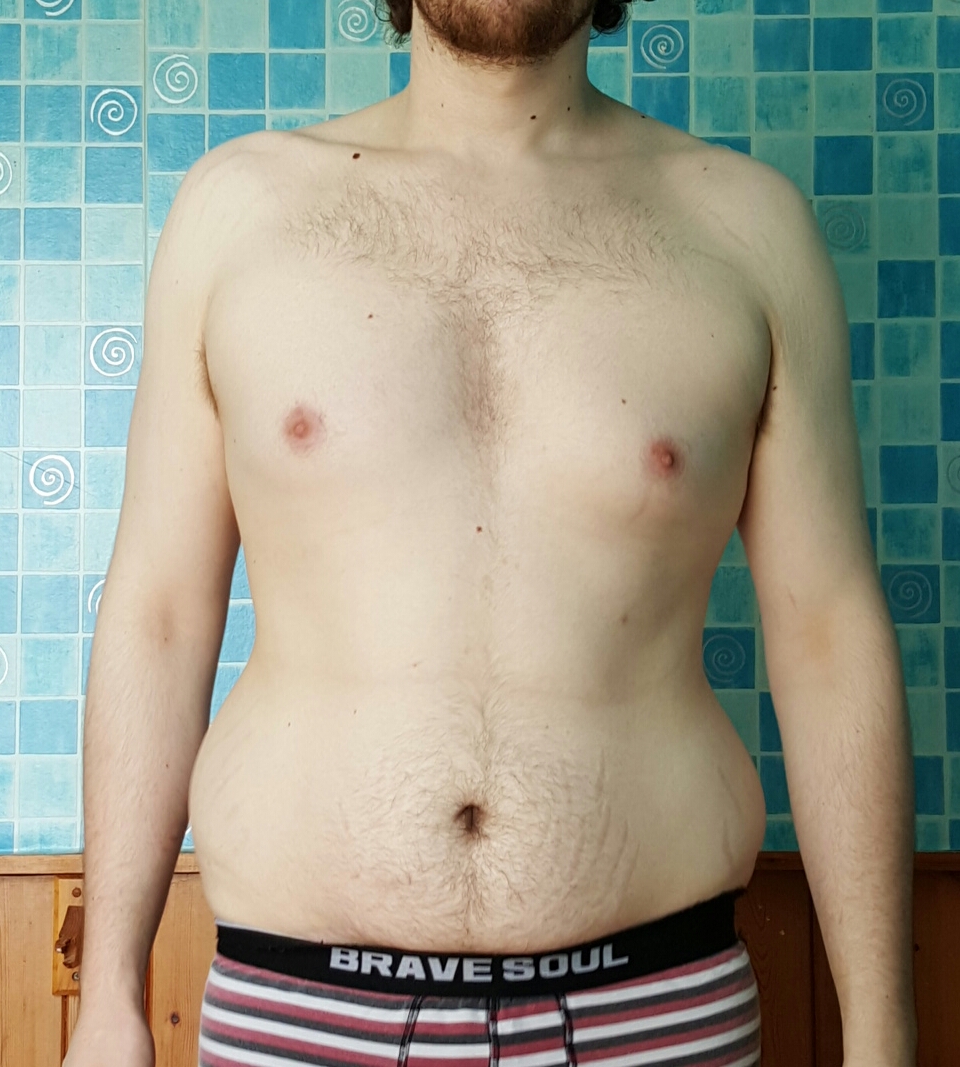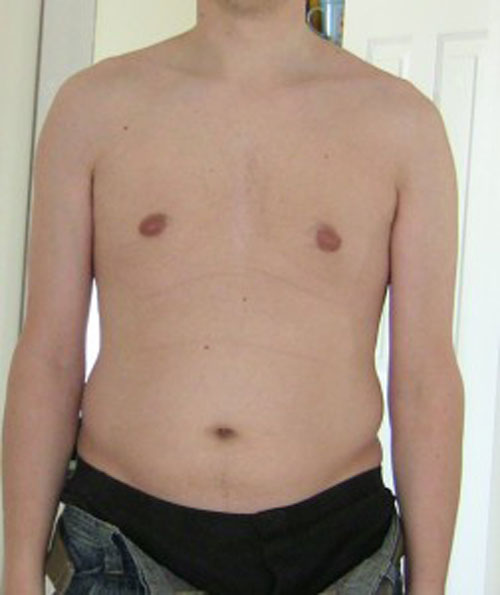KingOfRome
Buff Auschwitz Escapee
-
- Joined
- Jan 17, 2018
- Posts
- 8,039
I'm making this thread as an addendum to my thread 'HOW TO FIX SKINNY FAT ONCE AND FOR ALL', where I recommended a rapid fat loss protocol as the most effective and efficient way to break out of the skinny fat body type. While my stance on the matter hasn't changed, I do understand that what essentially amounts to a protein-sparing modified fast with added weight training is not a manageable or attractive option for every one of you who may be struggling with skinny fatness, so I'm going to give you other options that I, although wouldn't personally recommend, would accept as reasonable ways to escape skinnyfat.
These options are ordered from what I would most recommend to what I would least recommend, and I'm not including options that I believe would be a mistake, such as bulking above 20% body fat. All these options are also assuming you're weight training on an acceptable program.
Type I: Skinny FAT


More fat than skinny. Most skinnyfats fit into this category. You look like an avocado or a potato with toothpicks for arms. Body fat percentage is probably 18-22%. A loose-fitting shirt probably doesn't fool people into thinking you're not chubby like it would for your leaner Type II counterparts. Probably can't do a pull-up or take your shirt off in public without wanting to be struck dead on the spot. You likely have a fat baby face with little to no jaw definition.
Here are your options:
1. Rapid fat loss
Here, you would be aiming to lose around 2 pounds per week, preferably a bit more for your first few weeks. Protein should be at 0.8-1.2 grams per pound of bodyweight, you should lift, and your daily caloric deficit should be around 1000. You can expect to diet like this for 12-16 weeks, or more depending on your adherence, tracking your weight loss and adjusting your caloric intake to adjust for your decreasing body mass until you get to sub 14% body fat. Expect to be painfully skinny by the end.
2. Moderate fat loss
This entails weight loss of 1 pound per week, with the same variables as above but with a smaller daily caloric deficit of 500. With this, you have a slightly better chance of achieving body recomposition, i.e. concurrent muscle gain and fat loss, but that is not to be expected. This approach will take about twice as long as the first one, and you'll still probably be skinny.
3. Body recomposition with slight fat loss focus
You would lose a bit less than half a pound a week with this approach. Same protocol as above with a slight caloric deficit of 200. This will be a brutally slow process that might not even happen at all if you have poor genetics. Expect to become Type III Skinnyfat before your recomposition slows down to a grind more tedious than you can reasonably handle.
Type II: SKINNY Fat


More skinny than fat. A loose shirt hides your chub pretty well, but once the shirt comes off, you look like a porker. Body fat percentage is probably at or slightly above 15%. Honestly not terrible; better than most guys. You probably have a normal-looking face, at least as far as fatness is concerned, or you may have stubborn face fat.
Here are your options:
1. Rapid fat loss
Unlike your Type I counterparts, you should only need 4-8 weeks of aggressive dieting to get lean enough to not be skinnyfat.
2. Moderate fat loss
With fat loss of one pound per week, your chances of body recomposition are lower for you than they are for your Type I counterparts due to your lower body fat percentage, but you should get to a decent body fat percentage sooner than they would.
3. Body recomposition with no weight change
Eating at your caloric maintenance may or may not result in concurrent muscle growth and fat loss, though it might be worth a try if you're willing to give your genetic makeup the benefit of the doubt. It does happen for most to a reasonable degree.
4. Lean Bulk
As you are relatively lean, you have the option to set fat loss aside and focus on gaining muscle size. A slight caloric surplus of around 200 per day should be sufficient to fuel optimal muscle growth while leaving your current body fat percentage largely unchanged. After several months to a year of lean bulking, you should look leaner despite not having a lower body fat percentage. If you have good genetics, you might even see a slight decrease in body fat percentage. Not recommended if you have stubborn face fat.
Type III: Trained Skinnyfat

You have some newbie muscle from lifting or some other sport, but it's not enough to detract from the overall skinnyfat look, and people would be surprised if you told them you lifted weights. Chances are you were a Type I who got stuck here after following Option 3 for a while, or a Type II who tried to follow Option 4 but ate too much and ended up here.
Here are your options:
1. Rapid fat loss.
Due to your higher muscle mass, this will be easier and/or faster for you than it would be for a Type I or II. However, you will need to be careful with this as you're more likely to burn off your hard-earned gains if you're reckless.
2. Moderate fat loss.
Your fat loss will take longer, but you're more likely to retain muscle, and might even build a tiny bit more with good genetics.
These options are ordered from what I would most recommend to what I would least recommend, and I'm not including options that I believe would be a mistake, such as bulking above 20% body fat. All these options are also assuming you're weight training on an acceptable program.
Type I: Skinny FAT


More fat than skinny. Most skinnyfats fit into this category. You look like an avocado or a potato with toothpicks for arms. Body fat percentage is probably 18-22%. A loose-fitting shirt probably doesn't fool people into thinking you're not chubby like it would for your leaner Type II counterparts. Probably can't do a pull-up or take your shirt off in public without wanting to be struck dead on the spot. You likely have a fat baby face with little to no jaw definition.
Here are your options:
1. Rapid fat loss
Here, you would be aiming to lose around 2 pounds per week, preferably a bit more for your first few weeks. Protein should be at 0.8-1.2 grams per pound of bodyweight, you should lift, and your daily caloric deficit should be around 1000. You can expect to diet like this for 12-16 weeks, or more depending on your adherence, tracking your weight loss and adjusting your caloric intake to adjust for your decreasing body mass until you get to sub 14% body fat. Expect to be painfully skinny by the end.
2. Moderate fat loss
This entails weight loss of 1 pound per week, with the same variables as above but with a smaller daily caloric deficit of 500. With this, you have a slightly better chance of achieving body recomposition, i.e. concurrent muscle gain and fat loss, but that is not to be expected. This approach will take about twice as long as the first one, and you'll still probably be skinny.
3. Body recomposition with slight fat loss focus
You would lose a bit less than half a pound a week with this approach. Same protocol as above with a slight caloric deficit of 200. This will be a brutally slow process that might not even happen at all if you have poor genetics. Expect to become Type III Skinnyfat before your recomposition slows down to a grind more tedious than you can reasonably handle.
Type II: SKINNY Fat

More skinny than fat. A loose shirt hides your chub pretty well, but once the shirt comes off, you look like a porker. Body fat percentage is probably at or slightly above 15%. Honestly not terrible; better than most guys. You probably have a normal-looking face, at least as far as fatness is concerned, or you may have stubborn face fat.
Here are your options:
1. Rapid fat loss
Unlike your Type I counterparts, you should only need 4-8 weeks of aggressive dieting to get lean enough to not be skinnyfat.
2. Moderate fat loss
With fat loss of one pound per week, your chances of body recomposition are lower for you than they are for your Type I counterparts due to your lower body fat percentage, but you should get to a decent body fat percentage sooner than they would.
3. Body recomposition with no weight change
Eating at your caloric maintenance may or may not result in concurrent muscle growth and fat loss, though it might be worth a try if you're willing to give your genetic makeup the benefit of the doubt. It does happen for most to a reasonable degree.
4. Lean Bulk
As you are relatively lean, you have the option to set fat loss aside and focus on gaining muscle size. A slight caloric surplus of around 200 per day should be sufficient to fuel optimal muscle growth while leaving your current body fat percentage largely unchanged. After several months to a year of lean bulking, you should look leaner despite not having a lower body fat percentage. If you have good genetics, you might even see a slight decrease in body fat percentage. Not recommended if you have stubborn face fat.
Type III: Trained Skinnyfat

You have some newbie muscle from lifting or some other sport, but it's not enough to detract from the overall skinnyfat look, and people would be surprised if you told them you lifted weights. Chances are you were a Type I who got stuck here after following Option 3 for a while, or a Type II who tried to follow Option 4 but ate too much and ended up here.
Here are your options:
1. Rapid fat loss.
Due to your higher muscle mass, this will be easier and/or faster for you than it would be for a Type I or II. However, you will need to be careful with this as you're more likely to burn off your hard-earned gains if you're reckless.
2. Moderate fat loss.
Your fat loss will take longer, but you're more likely to retain muscle, and might even build a tiny bit more with good genetics.





